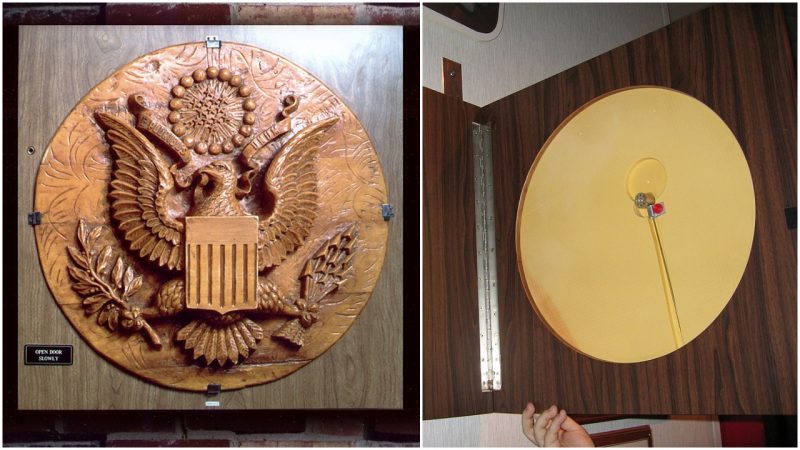Intelligence-gathering and espionage were top priorities for both the Eastern and the Western Bloc during the long Cold War, and as such, they undoubtedly shaped world politics of the era. Although it was romanticized by the movie industry, real-life espionage was actually a dangerous business during the Cold War and that is why participants of the conflict relied heavily on technology.
Considered by many to be the golden age of espionage, the Cold War takes full responsibility for the invention of a variety of highly sophisticated spying devices used by secret agents on both sides. But while Western technology was without a doubt a step further in the race, this was not the case when it came to electronic bugging–the Soviets were the masters in this field and they have proven this on more than one occasion.
Perhaps the best-known Cold War bugging example is that of The Thing, also known as The Great Seal Bug, a listening device implanted in a replica of the Great Seal of the United States and presented by Soviet schoolchildren to Averell Harriman, the U.S. ambassador to the U.S.S.R.
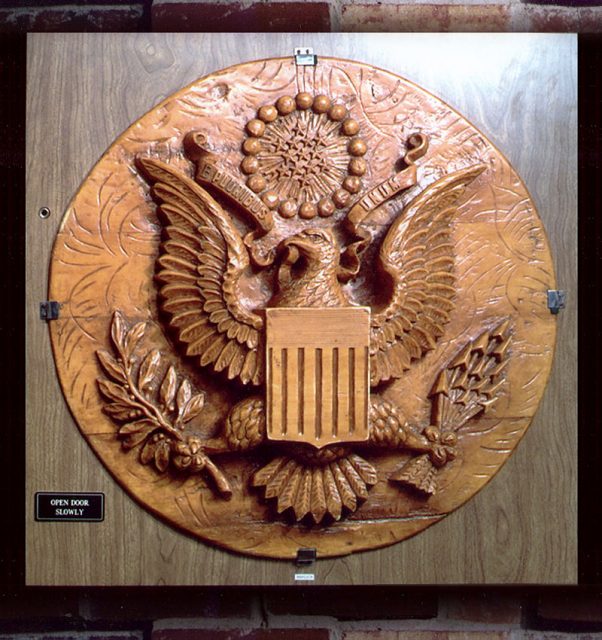
The beautifully hand-carved replica of the Great Seal was presented by the Soviets as a gesture of friendship towards their World War II ally, but it turned out to be a “Trojan Horse” that would go undetected for quite a long time before U.S. technician Joseph Jacob Bezjian managed to discover it.
It was on August 4, 1945, that ambassador Averell Harriman received the gift. Harriman apparently liked the elaborate replica so much that he decided to hang it on the wall of his office, where it stayed nearly seven years and survived three more ambassadors: Walter Bedell Smith, Alan G. Kirk, and George F. Kennan, all of whom kept it on the wall of the office. Far from being a gesture of goodwill, it provided the Soviets with crucial information about the post-war activities of the United States until 1952, when an inspection revealed that the bald wooden eagle had been bugged.
Designed by Leon Theremin, a famed Soviet inventor, the device had no power source, which made it much more difficult for officials to detect. The small device could be activated only when the Soviets wanted to turn it on and they accomplished that with the help of a radio signal. Accounts vary, but it is believed that they remotely activated the device either from a van parked outside the ambassador’s residence or from a building across the street. What matters, however, is that The Thing was exceptionally reliable and, more importantly, it took years before the State Department became suspicious that the residence had been bugged.
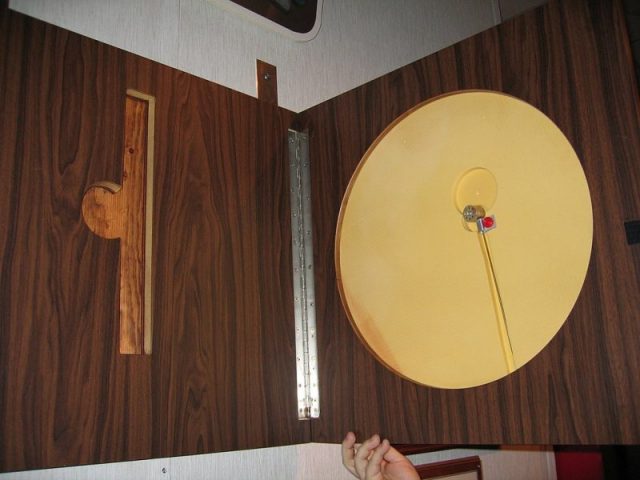
CC BY-SA 2.0
“The bugging of foreign embassies and other official premises had of course been for many years, even back into the 1930s, a standard practice of the Soviet government, and not of that government alone. We had long since taught ourselves to assume that in Moscow most walls–at least in rooms that diplomats were apt to frequent–had ears,” wrote George Kennan, the U.S. ambassador to the U.S.S.R. at the time the listening device was found, in his memoirs.
Things started getting quite awkward when in 1951 a British radio operator unexpectedly overheard a conversation on an open radio channel, coming most likely from the ambassador’s residence. Experts were soon on their way to Moscow to investigate the matter, but there was nothing unusual to be found in the residence, except for the presence of strong radio frequency signals when the Soviets would turn on the device. It didn’t take long before another conversation coming from the residence was overheard by U.S. officials. This time, technicians John Ford and Joseph Bezjian came to Moscow and began a more detailed investigation, but they also didn’t find anything.
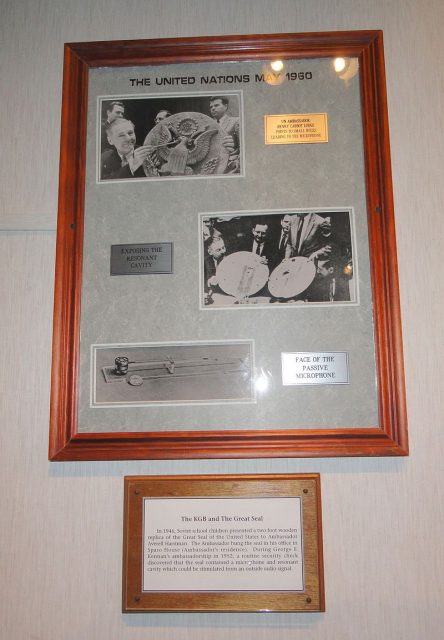
Bezjian was apparently not satisfied with the results of the previous investigations and decided to conduct a more extensive search during the fall of 1952. He had his equipment sent earlier and posed as a “house guest” to ambassador George Kennan, but still, he was unable to locate the bug. Not willing to give up, Bezjian came up with a rather unconventional plan, according to which the ambassador was supposed to dictate an unclassified piece of text to his secretary, Dorothy Hessman, in order to keep the snoopers busy while he searched the office with his receiver. He soon got a signal and realized that the bug was being hidden somewhere behind the hand-carved replica of the Great Seal of the United States, but upon removing the plaque from the wall the signal disappeared, which led him to conclude that the bug had been placed inside the precious Soviet gift.
“Quivering with excitement, the technician extracted from the shattered depths of the seal a small device, not much larger than a pencil, which, he assured me, housed both a receiving and a sending set, capable of being activated by some sort of electronic ray from outside the building. When not activated, it was almost impossible to detect. When activated, as it was on that evening, it picked up any sounds in the room and relayed them to an outside monitor, who presumably had his stance in one of the surrounding buildings,“ wrote George Kennan in his memoirs.
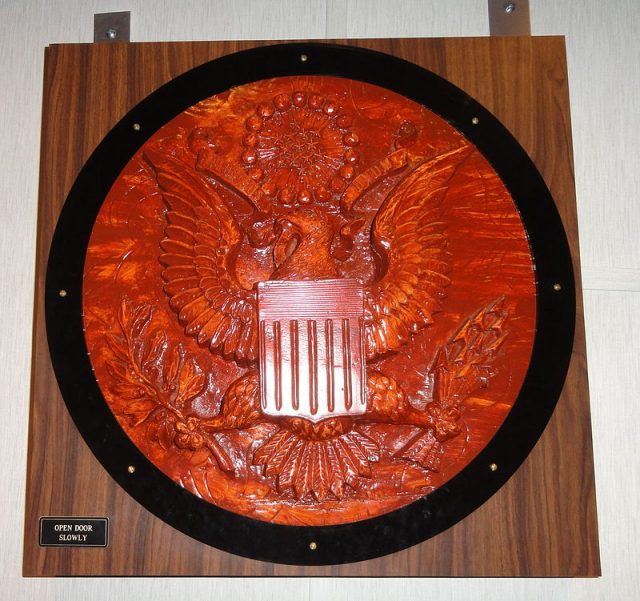
In an era full of tension and uncertainty, the mysterious bug surely provided vital intelligence to the Soviets, but in the long term it proved to be quite harmful to their international reputation.
Eight years later, the Soviets shot down an American U-2 spy plane in Soviet airspace (the 1960 U-2 incident) and accused the U.S. of spying. An urgent meeting of the United Nations Security Council was requested by the Foreign Affairs minister of the U.S.S.R. and a draft resolution was submitted under which the Security Council would have condemned the U-2 flights as aggressive acts and prevented their recurrence. However, American officials disclosed the existence of the Soviet bug in order to prove that the Soviets were also spying on them, and the resolution was defeated with 7-2 votes in favor of the United States.
